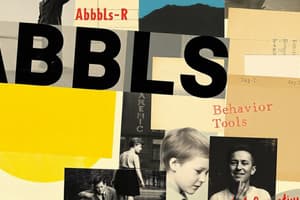Podcast
Questions and Answers
What is the primary purpose of the ABLLS-R?
What is the primary purpose of the ABLLS-R?
- To evaluate a child's physical fitness levels
- To identify a child's strengths and weaknesses in communication and learning (correct)
- To assess a child's emotional intelligence
- To measure a child's artistic skills
Which section of the ABLLS-R specifically evaluates a child's basic learner skills?
Which section of the ABLLS-R specifically evaluates a child's basic learner skills?
- Motor Skills Assessment
- Self-Help Skills Assessment
- Academic Skills Assessment
- Basic Learner Skills Assessment (correct)
Which of the following is a benefit of using the ABLLS-R?
Which of the following is a benefit of using the ABLLS-R?
- It provides a clear evaluation of a child's emotional state
- It eliminates the need for any progress tracking
- It assesses only academic performance
- It helps in creating individualized education plans (IEPs) (correct)
What challenge may arise during the implementation of the ABLLS-R?
What challenge may arise during the implementation of the ABLLS-R?
What does the VB-MAPP primarily focus on?
What does the VB-MAPP primarily focus on?
What is the primary purpose of the VB-MAPP Milestones Assessment?
What is the primary purpose of the VB-MAPP Milestones Assessment?
Which age range does the VB-MAPP Milestones Assessment primarily target?
Which age range does the VB-MAPP Milestones Assessment primarily target?
What does the VB-MAPP Barriers Assessment focus on?
What does the VB-MAPP Barriers Assessment focus on?
How many assessment areas does the VB-MAPP Transition Assessment contain?
How many assessment areas does the VB-MAPP Transition Assessment contain?
What type of skills are assessed in the VB-MAPP Milestones Assessment?
What type of skills are assessed in the VB-MAPP Milestones Assessment?
What does a score of 5 in the transition assessment indicate?
What does a score of 5 in the transition assessment indicate?
Which of the following skills is evaluated in Level 1 of the VB-MAPP for children aged 0-18 months?
Which of the following skills is evaluated in Level 1 of the VB-MAPP for children aged 0-18 months?
Which of the following statements is a challenge related to the VB-MAPP?
Which of the following statements is a challenge related to the VB-MAPP?
What is the primary focus of the Assessment of Functional Living Skills (AFLS)?
What is the primary focus of the Assessment of Functional Living Skills (AFLS)?
Which area is NOT part of the skills assessed by the assessment described?
Which area is NOT part of the skills assessed by the assessment described?
Which of the following skills are part of Independent Living Skills?
Which of the following skills are part of Independent Living Skills?
What is a significant feature of the AFLS?
What is a significant feature of the AFLS?
In which domain would skills like managing money and shopping be evaluated?
In which domain would skills like managing money and shopping be evaluated?
The Essential for Living (EFL) assessment is specifically designed for individuals with which of the following characteristics?
The Essential for Living (EFL) assessment is specifically designed for individuals with which of the following characteristics?
Which of the following best describes the emphasis of the AFLS?
Which of the following best describes the emphasis of the AFLS?
Flashcards
ABLLS-R Purpose
ABLLS-R Purpose
Identifies a child's strengths and weaknesses in language and learning to create targeted interventions.
VB-MAPP Purpose
VB-MAPP Purpose
Evaluates a child's language, learning, and social skills to identify barriers and needs for curriculum development.
ABLLS-R Sections
ABLLS-R Sections
Includes sections for basic learner skills, academic skills, self-help skills, and motor skills assessments.
ABLLS-R Age Range
ABLLS-R Age Range
Signup and view all the flashcards
VB-MAPP Function
VB-MAPP Function
Signup and view all the flashcards
VB-MAPP Milestones
VB-MAPP Milestones
Signup and view all the flashcards
VB-MAPP Barriers
VB-MAPP Barriers
Signup and view all the flashcards
VB-MAPP Transition Score
VB-MAPP Transition Score
Signup and view all the flashcards
AFLS Purpose
AFLS Purpose
Signup and view all the flashcards
AFLS Domains
AFLS Domains
Signup and view all the flashcards
VB-MAPP Milestones Assessment
VB-MAPP Milestones Assessment
Signup and view all the flashcards
VB-MAPP Barriers Assessment
VB-MAPP Barriers Assessment
Signup and view all the flashcards
VB-MAPP Transition Assessment
VB-MAPP Transition Assessment
Signup and view all the flashcards
Inform IEP Development
Inform IEP Development
Signup and view all the flashcards
What is the AFLS?
What is the AFLS?
Signup and view all the flashcards
What are the key features of the AFLS?
What are the key features of the AFLS?
Signup and view all the flashcards
What is the EFL assessment?
What is the EFL assessment?
Signup and view all the flashcards
Who can benefit from the EFL assessment?
Who can benefit from the EFL assessment?
Signup and view all the flashcards
Why are these assessments linked to daily living?
Why are these assessments linked to daily living?
Signup and view all the flashcards
Study Notes
Week 13 Assessments
- Assessments covered include ABLLS-R, VB-MAPP, AFLS, and EFL.
The Assessment of Basic Language and Learning Skills, Revised (ABLLS-R)
- A comprehensive tool for evaluating a child's language and learning proficiency.
- Criterion-referenced assessment based on observation of child's skills.
- Ages Birth-12 years.
Purpose of ABLLS-R
- Identifies a child's strengths and weaknesses in communication and learning.
- Enables practitioners to develop targeted interventions promoting effective learning and enhancing language proficiency.
Section 1: Basic Learner Skills Assessment
- Includes categories such as cooperation, visual performance, receptive language, imitation, vocal imitation, requests, labeling, intraverbals, spontaneous vocalizations, syntax & grammar, play, social interaction, group instruction, classroom routines, and generalized responding.
Section 2: Academic Skills Assessment
- Includes reading, math, writing, and spelling skills.
Section 3: Self-Help Skills
- Includes dressing, eating, grooming, and toileting skills.
Section 4: Motor Skills Assessment
- Includes gross and fine motor skills.
VB-MAPP Milestones Assessment
- Criterion-referenced assessment for children ages 0-4 with language delays.
- Designed to provide a representative sample of a child's existing verbal and related skills.
- Includes 170 measurable learning and language milestones across three developmental levels (0-18 months, 18-30 months, and 30-48 months).
- Assesses skills including mand, tact, echoic, intraverbal, listener, motor imitation, independent play, social play, visual perceptual skills, matching-to-sample, linguistic structure, group & classroom skills, and early academics.
- The Early Echoic Skills Assessment (EESA) is included.
VB-MAPP Barriers Assessment
- Assesses 24 common learning and language acquisition barriers faced by children with autism and other developmental disabilities.
- Includes areas such as behavioral problem, instructional control, defective communication, ineffective visual perception and matching to sample, limited listener skills, defective intraverbal skills, limited social skills, prompt dependency, defective scanning skills, lack of generalization, weak motivators, limited response requirement, reinforcement dependency, self stimulation, inappropriate articulation, obsessive-compulsive behavior, hyperactivity, difficulty making eye contact and sensory defensiveness.
VB-MAPP Transition Assessment
- Contains 18 assessment areas to identify whether a child is making progress and has acquired the necessary skills for a less restrictive educational environment.
- Can assist IEP teams in decision-making and prioritizing educational needs.
- Includes several summary measures, aspects of the VB-MAPP Milestones and Barriers Assessment, as well as skills that impact transition including negative behaviors, classroom routines and group skills, social skills, independence, generalization, variations of reinforcers, rate of skill acquisition, retention, exposure to natural environment, transfer skills, adaptability, and skills related to self-care (eating, toileting).
Assessment of Functional Living Skills (AFLS)
- Skill ratings completed by parents, educators, or therapists using observation, interview, and task performance-based information, along with task analyses and grid progress tracking..
- Ages 2 years and up.
Purpose of AFLS
- Comprehensive tool for assessing and teaching essential living skills for independent and effective functioning in daily life.
- Focuses on practical real-world skills across various settings.
Key Domains of AFLS
- Basic Living Skills (personal care, hygiene, safety, environment maintenance), Home Skills (household management, tasks), Community Participation Skills (public transportation, shopping, interaction), School Skills (school participation), Vocational Skills (employment readiness, tasks), Independent Living Skills (independence, emergencies, personal safety) and Social Skills (conversation, adhering to social rules).
Features of AFLS
- Individualized assessment allowing focus on relevant skill areas.
- Level-based scoring system (independent, with minimal assistance, or unable to perform).
- Progress monitoring to track changes and adjust interventions.
- Practical approach useful for transition planning to adulthood, community participation and independent living.
Essentials for Living Assessment (EFL)
- Curriculum-based assessment instrument that's also a curriculum.
- Designed for children and adults of all ages with moderate to severe disabilities.
- Includes numerous skills covering communication, language, daily living, social, functional academic, and tolerating skills alongside a domain for severe problem behavior.
- Consists of Must-Have Skills (Essential Eight): making requests, waiting, accepting removals, sharing/turns, completing tasks, following directions, performing daily living skills related to health and safety, and tolerating situations related to health and safety).
Functional Independence Skills Handbook (FISH)
- Material used to determine person’s ability to perform functional activities.
- Developed for special educators, paraeducators, and parents of people with severe developmental disabilities.
- Provides an assessment instrument to determine future goals. Sample lesson plans with teaching techniques.
- Covers seven domains: Adaptive behavior, Affect/emotions, Cognitive, Sensorimotor skills, Social skills, Speech/language, and Vocational skills.
Resources for Purchasing Assessments
- Websites and prices for ABLLS-R, VB-MAPP, AFLS, and EFL assessments.
Grading Rubric
- Rubric for evaluating project involving VB-MAPP, ABLLS-R, or AFLS assessment and report writing.
- Includes criteria for completion of assessments, accuracy of results, clarity/conciseness, and report structure/format.
Studying That Suits You
Use AI to generate personalized quizzes and flashcards to suit your learning preferences.




